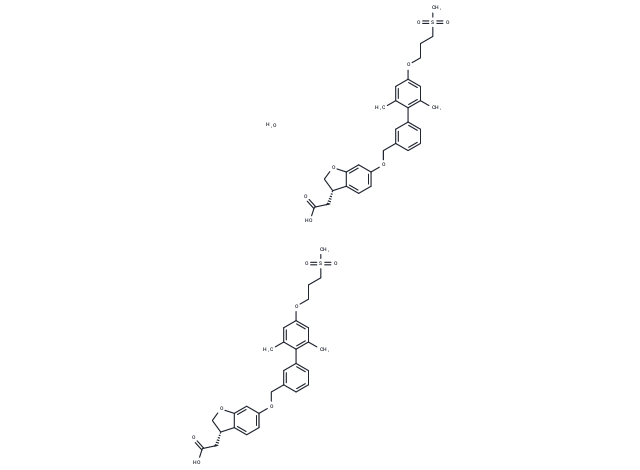Shopping Cart
- Remove All

Your shopping cart is currently empty


| Pack Size | Price | Availability | Quantity |
|---|---|---|---|
| 25 mg | $669 | 1-2 weeks | |
| 50 mg | $869 | 1-2 weeks | |
| 1 mL x 10 mM (in DMSO) | $322 | 1-2 weeks |
| Description | TAK-875 Hemihydrate (Fasiglifam) is a selective GPR40 agonist with EC50 of 14 nM, 400-fold more potent than oleic acid. |
| Targets&IC50 | FFA1/GPR40:14 nM(EC50) |
| In vitro | TAK-875 exhibits potent agonist activity and high binding affinity to the human GPR40 receptor with Ki of 38 nM. TAK-875 displays weaker affinity toward the rat GPR40 receptor with Ki of 140 nM. TAK-875 displays excellent selectivity, as TAK-875 has little agonist potency to other members of the FFA receptor family with EC50 of >10 μM. [1] TAK-875 treatment induces a concentration-dependent increase in intracellular IP production in CHO-hGPR40 with EC50 of 72 nM, more potently than that of endogenous ligand agonist oleic acid which requires much higher ligand concentrations to activate the receptor with EC50 of 29.9 μM. Neither TAK-875 nor oleic acid elicits an IP response in control CHO cells devoid of hGPR40. Consistent with the activation of the Gqα-mediated signaling pathway, TAK-875 augments glucose-dependent insulin secretion in pancreatic β cells. Prolonged stimulation of GPR40/FFA1 by TAK-875 does not cause pancreatic β Cell dysfunction or induction of apoptosis. [2] |
| In vivo | In a rat model of diabetes, single oral dosing of TAK-875 at 0.3-3 mg/kg reduces the blood glucose excursion and augments insulin secretion during an oral glucose tolerance test, when TAK-875 is administered 1 hour before an oral glucose challenge. [1] In type 2 diabetic N-STZ-1.5 rats, administration of TAK-875 (1-10 mg/kg p.o.) shows a clear improvement in glucose tolerance and augments insulin secretion. Additionally, TAK-875 (10 mg/kg, p.o.) significantly augments plasma insulin levels and reduces fasting hyperglycemia in male Zucker diabetic fatty rats, whereas in fasted normal Sprague-Dawley rats, TAK-875 neither enhances insulin secretion nor causes hypoglycemia even at 30 mg/kg. [2] |
| Alias | TAK-875, Fasiglifam |
| Molecular Weight | 533.63 |
| Formula | C29H32O7S·1/2H2O |
| Cas No. | 1374598-80-7 |
| Storage | Powder: -20°C for 3 years | In solvent: -80°C for 1 year | Shipping with blue ice. | |||||||||||||||||||||||||||||||||||
| Solubility Information | Ethanol: <1 mg/mL DMSO: 93 mg/mL (174.3 mM) H2O: <1 mg/mL | |||||||||||||||||||||||||||||||||||
Solution Preparation Table | ||||||||||||||||||||||||||||||||||||
DMSO
| ||||||||||||||||||||||||||||||||||||

Copyright © 2015-2024 TargetMol Chemicals Inc. All Rights Reserved.